Indus Valley Civilisation: Origins, Growth, and Legacy
Indus Valley Civilization : Indus – Saraswati Velly Civilization stands as one of the world’s oldest and most sophisticated civilisations. Flourishing over 5,000 years ago in the northwestern parts of the Indian subcontinent.
This civilisation was known for its remarkable urban planning, advanced architecture, and impressive craftwork.
But how did it all begin? What made it so unique? And why did it eventually decline? Let’s explore the journey of the Indus Valley Civilisation …
Why Did the Indus Valley Civilisation Begin?
Every great civilisation has a starting point, and for IVC, it began with rural life. Long before cities like Harappa and Mohenjodaro appeared, people lived in small farming villages.
The transition from rural settlements to urban centres was not sudden. It took centuries of growth in agriculture, technology, and trade.
One of the earliest sites, Mehrgarh, located in present-day Pakistan, played a key role. Dating back to around 7000 BCE, Mehrgarh is considered the seedbed of the later Indus Valley culture.
Here, people started domesticating animals, growing crops, and making pottery. This agricultural surplus eventually allowed communities to grow larger and more complex, laying the foundation for urban life.
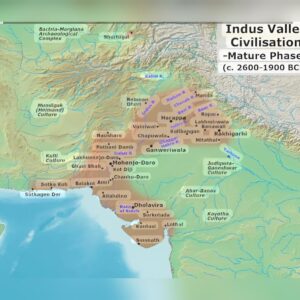
What is Indus Valley Civilisation?
The Indus Valley Civilisation, also called Harappan Civilization and Indus – Saraswati was an ancient urban culture that flourished roughly between 3300 BCE and 1300 BCE.
At its peak (around 2600 BCE to 1900 BCE), it covered over 1.25 million square kilometres — from eastern Afghanistan to Gujarat and from Balochistan to western Uttar Pradesh.
It had:
- Planned cities
- Brick houses
- Advanced drainage systems
- Great public buildings
- Craft and trade specialisation
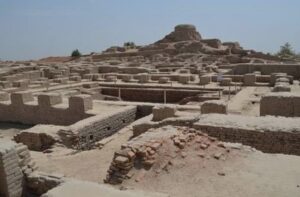
Mohenjodaro city
It was primarily located around the Indus and Saraswati River and its tributaries, along with the now seasonal Ghaggar-Hakra River, linked to the Saraswati River from the Rig Veda.
How Was the Indus Valley Civilisation Discovered?
Until the 1920s, no one knew about the grandeur of the Indus Valley Civilisation.
Early British explorers like Alexander Burnes and Charles Masson visited the ruins near Harappa in the 1800s. However, they assumed the ruins were linked to Alexander the Great.
In 1872, Alexander Cunningham, director of the Archaeological Survey of India (ASI), found a seal at Harappa, but he dismissed it as foreign.
Only in 1921, when Dayaram Sahni excavated Harappa and R.D. Banerjee explored Mohenjodaro (in 1922), did the truth come out — this was a previously unknown, advanced Bronze Age civilisation.
British archaeologists like John Marshall and Mortimer Wheeler helped bring global attention to the discovery.
As more sites were found — over 1,000 by now — scholars realised it was far bigger than just Harappa, so the name changed to Indus Valley Civilisation (IVC).
Later, as sites far from the Indus River were uncovered, it was even called Indus Civilisation or Saraswati Civilisation .
What Made Indus Valley Civilization Cities Special?
Unlike the chaotic sprawl of many ancient cities, Indus Valley cities were neatly planned.
The most famous ones — Harappa, Mohenjodaro, Dholavira, Lothal, and Kalibangan — followed a grid pattern with roads intersecting at right angles.
Key features:
- Burnt bricks for construction (uniform in size)
- Citadel (highted fort) and lower town divisions
- Underground drainage systems
- Granaries, public baths, and wells
- Standardised weights and measures
- Goddess Earth statue
- Dockyard in citie like Lothal
- Foreign trade with mesopotamian
The cities reflect an advanced understanding of civil engineering, architecture, and urban governance.
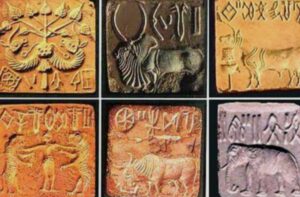
How Did Indus Valley Civilization People Live and Work?
The people of IVC were skilled artisans, traders, and farmers.
Their economy was based on:
- Agriculture: Wheat, barley, mustard, dates, and cotton were cultivated.
- Domesticated animals: Cattle, sheep, goats, and even elephants.
- Crafts: Bead-making, pottery, seal carving, and metallurgy (copper, bronze, gold, silver — no iron).
- Trade: With Mesopotamia (Sumer), Afghanistan, and Central Asia. Goods like lapis lazuli, carnelian, and tin were imported.
Tools, ornaments, and everyday items show a high level of skill and aesthetic sense.
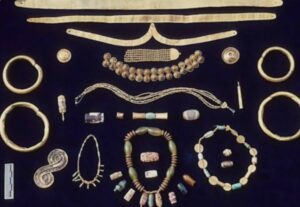
What Was Unique About Indus Valley Civilisation ?
Many elements make Indus Valley Civilization unique:
- Writing system: Still undeciphered. Known as the Harappan script, it was written on seals and tablets but remains a mystery.
- No known rulers or kings: Unlike Egypt or Mesopotamia, no large statues or royal graves have been found.
- Religious life: Evidence of fertility mother goddess figurines, and possible proto-Shiva figures, but no large temples.
- Uniformity: Standard bricks, weights, and town layouts across far-flung regions hint at a strong cultural connection.
When Did Indus Valley Civilisation Flourish and Decline?
Historians divide IVC into three phases:
- Early Harappan (3300–2600 BCE) – Proto-urban phase; craft specialisation begins; early cities emerge.
- Mature Harappan (2600–1900 BCE) – Peak of urban life; large cities, trade, standardisation.
- Late Harappan (1900–1300 BCE) – Decline phase; urban centres fade; shift back to rural life.
The Indus Valley Civilization didn’t vanish overnight but gradually declined over centuries.
Why Did Indus Valley Civilisation Decline?
There’s no single reason, but several factors might have contributed:
- Changing rivers: The drying or shifting of the Ghaggar-Hakra / Saraswati river likely hurt agriculture and water supply.
- Earthquakes or floods: Geological events could have damaged infrastructure or caused migrations.
- Decline in trade: Disruption in long-distance trade, especially with Mesopotamia, may have weakened the economy.
- Environmental stress: Deforestation, soil exhaustion, or climate change could have reduced crop yields.
- Internal social changes: Lack of strong political or military structures might have made them vulnerable.
There’s no evidence of war, invasion, or epidemics causing a sudden collapse of the Indus Valley Civilization.Most likely, it was a mix of natural and gradual decline.
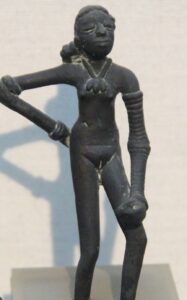
How Does the Indus Valley Civilisation Compare to Others?
Around the same time, other civilisations also developed:
- Mesopotamia Tigris-Euphrates Civilization around 3500–500 BCE
- Egyptian Nile 3100–2000 BCE Hieroglyphics
- Chinese Huang He (Yellow River) 2100 BCE onwards Oracle Bones
- Indus Valley Indus & Ghaggar-Hakra 3300–1300 BCE Harappan script (undeciphered)
Indus Valley stands out for its urban planning, lack of royal monuments, and mysterious script. Indus valley civilization was also the largest in geographical area.
Where Were the Main Indus Valley Sites Located?
Here are some major IVC sites and their features:
A. Harappa Punjab
- Pakistan First site discovered
- Granaries found
B. Mohenjodaro Sindh, Pakistan
- Great Bath for some rituals
- granaries largest
- Statue of prist
C. Dholavira Gujarat, India
- Reservoirs around city
- signboard containing language
D. Lothal Gujarat, India
- Dockyard for foreign trade via sea
- bead making factory
E. Kalibangan Rajasthan, India
- Fire altars suggest that early Vedic culture
- ploughed fields
F. Banawali Haryana, India
- Fortification of city
- jewellery of different metals

How Do We Know All This?
Thanks to archaeological excavations, scientists have pieced together much of what we know.
Indian and foreign archaeologists have studied layers of earth, unearthed pottery, seals, tools, and skeletons.
Prominent archaeologists to discover Indus Valley Civilization:
- Dayaram Sahni (uncovered Harappa)
- R.D. Banerjee (Mohenjodaro)
- Sir John Marshall (Publicised the discovery)
- Jean-François Jarrige (Mehrgarh excavations)
- Richard Meadow & R.M. Hegde (Recent research)
What’s the Legacy of the Indus Valley Civilisation Today?
Although we can’t read their writing, the cultural legacy of IVC lives on:
- Brick architecture still used in villages.
- Bangles, beads, and designs in Indian jewellery resemble Harappan styles.
- Town planning and water management in ancient India began here.
The peaceful nature of the society is often praised. Many Indians today feel pride in knowing that their ancestors built one of the earliest civilisations of human history.
Why Indus Valley Civilisation Still Matters ?
The Indus Valley Civilisation shows how an ancient people, without kings or armies, created a peaceful and organised way of life.
They mastered urban planning, long-distance trade, and craftsmanship thousands of years ago.
Even though their script remains undeciphered, their cities continue to inspire archaeologists and historians around the world.
As we uncover more about the Indus Valley Civilisation, we realise it’s not just a chapter in textbooks — it’s a remarkable reminder of India’s ancient glory.
Read Also: Saif Ali Khan’s ancestral property declared ‘Enemy Property ‘ by Court
